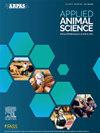Myosin heavy chain, myogenic regulatory factors, and steroid hormone receptor responses in serially slaughtered implanted or nonimplanted beef steers
IF 1.5
Q3 AGRICULTURE, DAIRY & ANIMAL SCIENCE
引用次数: 0
Abstract
Objective
The objective of this study was to quantify changes in beef steers in myosin-heavy-chain fiber type, myogenic regulatory factors, and steroid hormone receptors over time and in response to implantation in the longissimus dorsi (LD), semitendinosus (ST), and diaphragm (D) muscles.
Materials and Methods
Eighty beef steers were paired based on estimated final BW, and individuals received no implant (CON) or Revalor-XS (Merck Animal Health) administered at d 0 and 190 (IMP). Four pairs of steers were randomly assigned to slaughter group at 42-d intervals from d 0 to 378. At slaughter, samples were collected from the LD, ST, and D muscles of each animal for immunohistochemical analysis.
Results and Discussion
Proportions of cross-sectional area (CSA) occupied by each myosin-heavy-chain type were not different between implant treatments. Increased days on feed led to increased CSA in all muscles. Total nuclei density tended to be greater in CON steers. Myogenic regulatory factors expressed as a proportion of total nuclei led to no difference due to implant treatment in all variables, except a tendency for increased proportion of myonuclei in the ST of IMP steers. Day influenced all variables in the LD with positive quadratic effects on proportion of myonuclei and MYF5-positive nuclei. In the ST, day affected proportion of myonuclei and PAX7- and MYF5/ PAX7-dual-positive nuclei. All myogenic factors were affected by day in the D. Steroid receptor expression was unaffected by implant status regardless of muscle. Day tended to affect steroid receptor variables in the LD, ST, and D, with varying trends by muscle and variable.
Implications and Applications
Implant treatment did not alter the proportion of muscle fiber types, myogenic outcomes relative to total nuclei, or steroid hormone receptors. However, implant administration increased overall CSA by 9% to 16%, suggesting enhanced muscle growth without affecting muscle composition or regulatory mechanisms.
连续屠宰植入或未植入肉牛的肌球蛋白重链、肌生成调节因子和类固醇激素受体反应
本研究的目的是量化牛在背最长肌(LD)、半腱肌(ST)和横膈膜(D)肌肉植入后,肌球蛋白重链纤维类型、肌生成调节因子和类固醇激素受体随时间的变化。材料和方法根据估计的最终体重对80头肉牛进行配对,个体未接受植入物(CON)或在0和190 (IMP)时给予revor - xs(默克动物保健公司)。4对阉牛从第0 ~ 378天每隔42 d随机分为屠宰组。屠宰时,从每只动物的LD、ST和D肌肉中采集样本进行免疫组织化学分析。结果与讨论各肌球蛋白重链型所占的横截面积(CSA)比例在不同种植体处理间无显著差异。饲粮天数的增加导致所有肌肉CSA的增加。总核密度在对照组中更大。肌生成调节因子在总细胞核中所占比例的表达在所有变量中都没有差异,除了在IMP小鼠的ST中肌核比例有增加的趋势。日影响LD的所有变量,对my核和myf5阳性核的比例有正二次效应。在ST中,日晒影响了肌核和PAX7-和MYF5/ PAX7双阳性核的比例。类固醇受体的表达不受植入状态的影响,与肌肉无关。Day倾向于影响LD、ST和D的类固醇受体变量,随肌肉和变量的变化趋势不同。植物治疗没有改变肌纤维类型的比例、相对于总核的成肌结果或类固醇激素受体。然而,植入物使总体CSA增加了9%至16%,这表明在不影响肌肉成分或调节机制的情况下,肌肉生长得到了促进。
本文章由计算机程序翻译,如有差异,请以英文原文为准。
求助全文
约1分钟内获得全文
求助全文

 求助内容:
求助内容: 应助结果提醒方式:
应助结果提醒方式:


